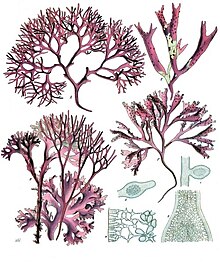Carrageen
| Irish moss | |
|---|---|
 |
|
| A-D Chondrus crispus ; E-F Mastocarpus stellatus | |
| Scientific classification | |
| Domain: | Eukaryota |
| (unranked): | Archaeplastida |
| Division: | Rhodophyta |
| Class: | Florideophyceae |
| Order: | Gigartinales |
| Family: | Gigartinaceae |
| Genus: | Chondrus |
| Species: | C. crispus |
| Binomial name | |
|
Chondrus crispus Stackh. |
|
| Nutritional value per 100 g (3.5 oz) | |
|---|---|
| Energy | 205 kJ (49 kcal) |
|
12.29 g
|
|
| Sugars | 0.61 g |
| Dietary fiber | 1.3 g |
|
0.16 g
|
|
|
1.51 g
|
|
| Vitamins | |
| Riboflavin (B2) |
(39%)
0.466 mg |
| Niacin (B3) |
(4%)
0.593 mg |
| Pantothenic acid (B5) |
(4%)
0.176 mg |
| Vitamin B6 |
(5%)
0.069 mg |
| Folate (B9) |
(46%)
182 μg |
| Vitamin C |
(4%)
3 mg |
| Vitamin E |
(6%)
0.87 mg |
| Vitamin K |
(5%)
5 μg |
| Minerals | |
| Calcium |
(7%)
72 mg |
| Iron |
(68%)
8.9 mg |
| Magnesium |
(41%)
144 mg |
| Manganese |
(18%)
0.37 mg |
| Phosphorus |
(22%)
157 mg |
| Sodium |
(4%)
61 mg |
| Zinc |
(21%)
1.95 mg |
|
|
|
|
|
| Percentages are roughly approximated using US recommendations for adults. Source: USDA Nutrient Database |
|
Chondrus crispus—commonly called Irish moss or carrageen moss (Irish carraigín, "little rock")—is a species of red algae which grows abundantly along the rocky parts of the Atlantic coast of Europe and North America. In its fresh condition this protist is soft and cartilaginous, varying in color from a greenish-yellow, through red, to a dark purple or purplish-brown. The principal constituent is a mucilaginous body, made of the polysaccharide carrageenan, which constitutes 55% of its weight. The organism also consists of nearly 10% protein and about 15% mineral matter, and is rich in iodine and sulfur. When softened in water it has a sea-like odour and because of the abundant cell wall polysaccharides it will form a jelly when boiled, containing from 20 to 100 times its weight of water.
Chondrus crispus is a relatively small sea alga, reaching up to a little over than 20 cm in length. It grows from a discoid holdfast and branches four or five times in a dichotomous, fan-like manner. The morphology is highly variable, especially the broadness of the thalli. The branches are 2–15 mm broad, firm in texture and the color ranges from light to dark green, dark red, purple, brown, yellowish, and white. The gametophytes (see below) often show a blue iridescence at the tip of the fronds and fertile sporophytes show a spotty pattern. (Stackhouse) Guiry is a similar species which can be readily distinguished by its strongly channelled and often somewhat twisted thallus. The cystocarpic plants of Mastocarpus show reproductive papillae quite distinctively different from Chondrus. When washed and sun-dried for preservation, it has a yellowish, translucent, horn-like aspect and consistency.
Chondrus crispus is common all around the shores of Ireland and can also be found along the coast of Europe including Iceland, the Faroe Islands western Baltic Sea to southern Spain. It is found on the Atlantic coasts of Canada and recorded from California in the United States to Japan. However, any distribution outside the Northern Atlantic needs to be verified. There are also other species of the same genus in the Pacific Ocean, for example, C. ocellatus Holmes, C. nipponicus Yendo, C. yendoi Yamada et Mikami, C. pinnulatus (Harvey) Okamura and C. armatus (Harvey) Yamada et Mikami.
...
Wikipedia
